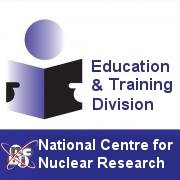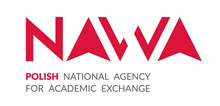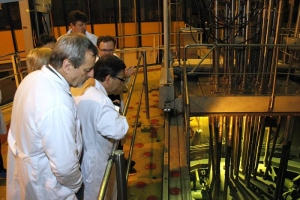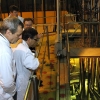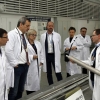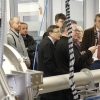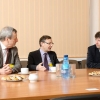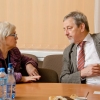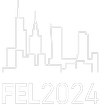EUROfusion officials in Świerk
2016.12.05 9:17 - adminProfessor A.J.H. Donne, EUROfusion international consortium Programme Manager, and Dr. X. Litaudon, Head of EUROfusion's ITER Physics Department visited NCBJ and met with Polish participants of the consortium. The guests were presented with NCBJ research/constructional potential that might be harnessed in R&D works on future fusion reactors.
The EUROfusion international consortium was established in 2014 by scientific institutions from 27 European countries. Its primary objective is to develop the technology of producing energy from controlled nuclear fusion reactions up to a point when industrial applications will become feasible. The ITER test facility currently under construction in Cadarache (France) is the first step on the way to demonstrate that feasibility. The planned DEMO facility is to be the next step; its construction is to be more favourable from the point of view of industrial-scale production of electric energy. However, no place has yet been selected for that facility, the time scale of the plans reach beyond 2050. Beforehand much research has yet to be done, both in physics and engineering aspects. These matters were discussed by Professor Donne and Dr. Litaudon during their stay in Poland. On the second day of their visit to Poland both EUROfision officials visited Świerk Research Centre.
Currently operated nuclear power plants are based on the fission nuclear reaction, in which heavy (usually uranium) nuclei disintegrate each into several lighter components of a combined mass smaller than mass of the initial nucleus. The missing mass is converted into energy according to the famous Einstein formula E=mc2. The fusion nuclear reaction, in which a pair of very light nuclei combine into a single more heavy nucleus may also release energy because in some cases (deuterium, tritium) combined mass of both merging constituents is larger than the final nucleus mass. However, each nucleus charged with a positive electrical charge repels all other nuclei, so the two light nuclei must be brought really close together in order to allow nuclear forces (acting at a very short range only) to overcome the repelling electrostatic forces. To that end deuterium or tritium is heated to unimaginably high temperatures, in which their nuclei move sufficiently fast to approach each other sufficiently close. Such conditions prevail inside stars enabling fusion reactions that supply energy radiated by stars to continually run. Scientists have been striving to recreate similar conditions on Earth in some well controlled environment (i.e. to develop a thermonuclear reactor) for many years. Thermonuclear reactors on Earth would be a practically inexhaustible source of cheap energy. On top of that, fusion nuclear reactions practically do not produce cumbersome radioactive waste.
However, it is a formidable scientific and engineering challenge to construct a thermonuclear reactor on Earth. Reactor constructional materials need to be carefully selected on the account of extreme conditions inside such a reactor. Both constructional and other materials used in the reactor vicinity (e.g. in control circuitry) must be resistant to extremely intense fluxes of neutrons emitted in thermonuclear reactions. No source of neutrons of appropriate energy currently available in any lab on Earth is intense enough. Researchers plan to develop a dedicated accelerator-based test facility, in which intense beams of neutrons would be produced by an very intense beam of accelerated deuterium nuclei striking a liquid lithium target.
Poland has been trying to host such a dedicated accelerator-based test facility on its territory. Polish research institutes, including NCBJ, might significantly contribute to its development, start-up, and operation. The visit of two EUROfusion officials in Świerk was an excellent opportunity for us to present our capacity and competences in that respect. Research on impact of high doses of neutrons on various constructional materials has been conducted at the MARIA research reactor for more than 40 years. In-house constructions of radiation detectors, plasma generators, plasma test devices/facilities, medical and industrial accelerators have been developed and used in Świerk also for a few tens of years. Recently CERN and DESY international research centres ordered in Świerk some parts for their research accelerators.
Polish participants of the meeting with EUROfusion officials in Świerk included Dr. Andrzej Gałkowski, Director of the Sylwester Kaliski Institute of Plasma Physics and Laser Microfusion (IFPiLM), Dr. Roman Zagórski, IFPiLM Deputy Director, Head of the New Technologies for the Power Industry Science-Industry Centre (CENTE), Professor Urszula Woźnicka, The Henryk Niewodniczański Institute of Nuclear Physics (IFJ), Dr. Marek Scholz (IFJ), Dr. Krzysztof Kurek, NCBJ Director General, Dr. Agnieszka Syntfeld-Każuch, NCBJ Deputy Director for Innovations and Implementations, Dr. Jacek Rzadkiewicz, (NCBJ, Chairman of the CENTE Governing Board).


